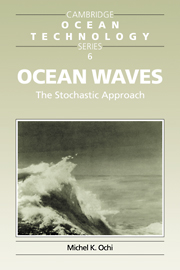Book contents
- Frontmatter
- Contents
- Preface
- 1 Description of random seas
- 2 Spectral analysis
- 3 Wave amplitude and height
- 4 Wave height and associated period
- 5 Sea severity
- 6 Estimation of extreme wave height and sea state
- 7 Directional characteristics of random seas
- 8 Special wave events
- 9 Non-Gaussian waves (waves in finite water depth)
- Appendix A Fundamentals of probability theory
- Appendix B Fundamentals of stochastic process theory
- Appendix C Fourier transform and Hilbert transform
- References
- Index
6 - Estimation of extreme wave height and sea state
Published online by Cambridge University Press: 15 October 2009
- Frontmatter
- Contents
- Preface
- 1 Description of random seas
- 2 Spectral analysis
- 3 Wave amplitude and height
- 4 Wave height and associated period
- 5 Sea severity
- 6 Estimation of extreme wave height and sea state
- 7 Directional characteristics of random seas
- 8 Special wave events
- 9 Non-Gaussian waves (waves in finite water depth)
- Appendix A Fundamentals of probability theory
- Appendix B Fundamentals of stochastic process theory
- Appendix C Fourier transform and Hilbert transform
- References
- Index
Summary
BASIC CONCEPT OF EXTREME VALUES
This section presents the theoretical background for predicting extreme values (extreme wave height, extreme sea state, etc.) which provide invaluable information for the design and operation of marine systems. The extreme value is defined as the largest value of a random variable expected to occur in a specified number of observations. Note that the extreme value is defined as a function of the number of samples. In the naval and ocean engineering area, however, it is highly desirable to estimate the largest wave height expected to occur in one hour, or the severest sea state expected to be encountered in 50 years, for example. This information can be obtained by estimating the number of waves (or sea states) per unit time, and thereby the number of samples necessary for evaluating the extreme value is converted to time.
The concept supporting the estimation of extreme values is order statistics which is outlined in the following. Let us consider a sample set consisting of wave heights taken in the sequence of observations (x1, x2, …, xn). Each element of the random sample xi is assumed to be statistically independent having the same probability density function f(x). In the case of wave height observations, each xi is considered to obey the Rayleigh probability law.
- Type
- Chapter
- Information
- Ocean WavesThe Stochastic Approach, pp. 149 - 174Publisher: Cambridge University PressPrint publication year: 1998
- 1
- Cited by



